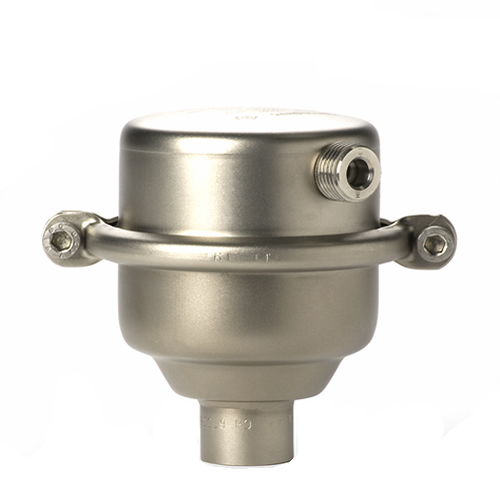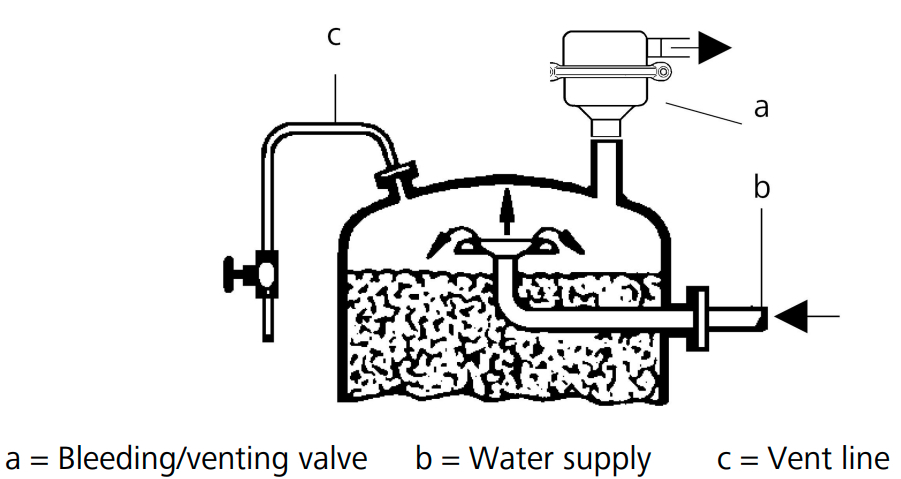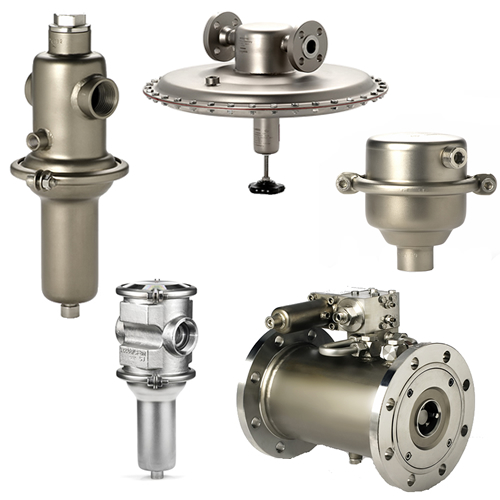Our selection of bleeding and venting valves are designed to remove air or gases automatically from/to tanks, vessels or pipelines. All our air vent valves are self-acting and float-controlled, designed to close as the liquid level rises and open as the liquid level falls.
Since 1885, our partner Mankenberg, have always been distinguished in their field, with unrivalled expertise and renowned technical know-how in providing fully optimised solutions with their range of self-acting pressure regulators, bleeding & venting valves, condensate & steam traps and level regulating float valves.
How do Bleeding Venting Valves Work?

Bleeding and venting valves work to remove or admit air or gases automatically within systems. They are self-operating mechanical valves that require no adjustment or external energy input to work once installed. A rising liquid level will lift the float and close the valve, in most cases via a system of levers. As the liquid level begins to drop, the valve will open and either admit air or vent air from the system. If the liquid level does start to drop it is because air is entering the system, or the plant is starting up.
Taking our time-tested EB1.12 continuous bleeding and venting valve as the example, this unit is a compact and lightweight valve primarily used in water treatment (including O-Zone) systems, petrochemical pipelines and storage tanks/vessels. They are manufactured completely from high quality deep-drawn 316L Stainless Steel for excellent corrosion resistant and the valve cone can be fitted with either soft or metallic seals (depending on media). The top and bottom sections of the valve body are connected by a clamp ring and two bolts for quick maintenance access with no requirements for special tooling. The simple and efficient design makes it easy to specify, install, handle and service these valves in even the harshest industrial environments.
Types of Bleed Vent Valves
We can offer three different types of bleeding and venting valves: continuous venting valves, startup venting valves and combined venting valves. These are summarised as follows:
- Continuous Bleeding & Venting – are used to remove air which accumulates in systems as a plant is in operation. They incorporate a lever system which enables them to operate at both very low and high pressures. Our EB1.12 and EB1.32 continuous bleeding and venting valves are the most popular and best-selling models.
- Startup Bleeding & Venting – are used to vent low pressure plant systems when they are starting up or being filled. The float acts directly on the cone and they have a large seat diameter to ensure fast venting for pressures below 0.1 BAR. During operation these valves are kept closed by the internal system pressure. A sudden vacuum causes them to open and equalise the pressure, preventing any damage which may normally occur. Click here to see our full range of start-up bleeding & venting valves.
- Combined Bleeding & Venting – are both start-up and continuous bleed/vent valves combined into one singular unit. They have both a large seat for the start-up operation and a small seat for the continuous operation, which are controlled by a float and system of levers. Both valve seats are open while the system is being filled and during operation the large seat is kept closed by the internal pressure. Any accumulating small air volumes are vented from the system via the small valve seat. If the pressure drops below 0.1 BAR, the large valve seat can open again. If a vacuum situation occurs (eg. by a pump failure) then the large seat opens instantaneously and prevents damage. Subsequently, if a pressure surge runs back through the pipeline, the large seat closes causing the air volume which has entered to act as a damper, while escaping to atmosphere through the small seat. Click here to see our full range of combined bleeding and venting valves.
For a more detailed look into how our continuous bleeding and venting valves function when installed, please watch our introductory video below:
Technical Considerations for Air Vent Valves
There are multiple different technical factors to consider when selecting any self-acting valve. In particular, the main operating factors that need to be considered for bleeding and venting valves are as follows:
- Operating Pressure (Min, Normal and Max Line Pressure usually BAR or PSI)
- Flow Rate (Q usually in Nm³/h or SCFM)
- Media Temperature (T usually in °C or °F)
- Media (To correctly selected the right body and seal materials)
- Line Size (To ensure the correct flow or discharge rate can be achieved, along with the required pipe connections)
These operating parameters are required to select a bleeding and venting valve for your system. It is also important that the unit sizes are observed, to ensure that the correct flow through or discharge rate can be achieved.
Some of the other important factors to consider when selecting our bleeding and venting valves are as follows:
- Materials – what construction materials should be used? This includes both the body material and any other wetted elastomer materials (such as the body and cone gaskets). Most of our standard bleeding and venting valves are typically constructed from high quality deep-drawn 316L Stainless Steel (1.4404), providing end users with excellent surface quality, high corrosion-resistance and an overall lightweight and compact unit. Before selecting a suitable construction material, you may need to consider both the flowing media and installation environment. If the unit is going to be used with particularly aggressive media or installed in demanding environments, it would be worth considering higher grade alloy materials such as Super Duplex (1.4410/1.4501), Duplex (1.4462) or Titanium (3.7025/3.7035) to ensure a long operational lifespan of the control valve. Some of our bleeding and venting valve models are available in Cast Iron or Epoxy Coating for particularly harsh environments.
Additionally, consideration must also be taken to the gasket/elastomer seal materials. If the standard EPDM will not work for your media, we can look at utilising FKM, FEPM, PTFE, Metallic and more to ensure complete fluid compatibility. Typically, our standard valves can be used for water up to +80°C and in certain cases up to +130°C (with higher temperature versions available as special requests). For O-Zone applications, we can supply versions with special elastomers. For hydrocarbon media such as petrol or gasoline we would recommend FPM. For hot mineral water, sea water and other liquids containing chloride we can consider feature coated bodies and internals. For corrosive media, we would typically consider rubber-coated valves or high-molybdenum materials.
- Connections – what is the line size the unit needs to fit on? Typically, most of our standard self-acting valves can range from sizes 1/2” up to 6” (or DN15 to DN150 in Nominal Diameter) and are available with a broad range of connection options including threaded, flanged, weld and other special connections.
As part of our catalogue offering, most of our self-acting valves are available with G Threaded (BSPP), NPT Threaded, DIN Flanges to EN 1092-1/11 Form B1, ANSI Flanges to RF, FF and RTJ, Welding Ends to ASME 16.25, DIN and ISO, Aseptic Clamps to DIN and ISO, Tri-Clamps to ASME BPE and more on special request.
- Special Considerations – are there any special conditions that may affect the choice of unit? Will the unit be installed in harsh environments? Are there any specific cleaning, testing or certification standards needed (such as DVGW conformity, FDA Conformity or Oxygen Cleaning)? Do you have a complex pipework setup? The more detail you can share with us, the better we will be able to advise you.
Advantages of Self Actuated Valves
Our complete range of self-acting control valves have always been renowned for their affordability, functional reliability and long operational lifespan. For over 100 years, Mankenberg have been standing for high quality and precision engineered control valves – all of which are designed to be seamless “fit and forget” solutions for our customers. Together, in partnership with Mankenberg, we strive to convince customers through unbeatable quality, excellent price/performance ratio and high on-time delivery performance.
With our consultation, the special advantages of our self-acting valves can include:
- Highest Safety Standards – Based on over 100 years of experience, the time-tested and proven designs of these valves offer end users uninterrupted functionality in systems, even in the event of a power failure, as there are no external electrical or pneumatical inputs required for operation. As the valves are completely self-acting, they offer fast response times and present no risk of maloperation.
- Low Cost of Ownership – Our valves offer customers an extremely low cost of ownership. Thanks to the specialist engineered design of the valve bodies, maintenance is made extremely easy. Most of our standard valve models utilise a clamp ring and bolt design allowing quick disassembly and access to internal components. All service kits for standard valves are kept at a low and affordable cost level, and in most cases are readily available to ship from stock.
- Ease of Assembly and Operation – Installation and assembly is made easy with our valves, with most standard valves having a very low net weight and compact design. Valves can be positioned and installed even in ‘difficult to navigate’ areas, such as tight spaces and complex pipework setups. The sturdy structures of the valve bodies make them suitable for operation in the harshest environments and demanding applications.
- Great Sustainability and Longevity – With the right consultation from us, our valves are designed to have the longest operational lifespan. With the correct selection for your individual application, these valves offer customers longevity, limited maintenance and hassle-free installation.
Bleeding & Venting Valve Applications
Our bleeding and venting valves can be considered for a huge selection of applications and industries from industrial water supply systems, to R&D/high-tech petrochemical rigs to UHP environments for food & beverage and pharmaceutical production. Some of the most common applications we work with are as follows:
- Water & Waste Water Treatment – including bleeding and venting of filters for thermal water in thermal baths, ozonisation for cold sterilisation of water and rapid filtration of raw water feeds.
- Oil & Gas – including degassing of natural gas liquids in crude oil production and venting of o-zone reactors.
- Marine & Defence – including ventilation of pipelines for the loading of oil onto ships, bleeding and venting of sea water desalination plants on cruise ships and air release from emergency diesel tanks.
- Food & Beverage – including water disinfection with o-zone in food production facilities.
Typical Installations for Self Venting Valves
Our vent valves should always be installed at high points in pipelines or vessels. Vent valves should not be installed on standpipes or in flushing lines, but at those points where air accumulates. A pipe run should be selected where the flow velocity is reduced, and if required, install a vent dome. You should always choose an installation site where the vent valve is not likely to “hammer” and therefore be damaged. The example below illustrates a typical installation setup for our EB1.12 continuous bleeding and venting valve:

If you have polluted or contaminated liquid media, then the vent valve must be cleaned occasionally. It is recommendable to install a stop valve between the tank, vessel resp. pipeline and the vent valve (only if the equipment cannot be depressurised easily).
Pressure surges or water hammer can destroy a valve float. For this reason, suitable protection devices should be considered for installation in a system. You should always select an operating pressure range which covers the maximum pressure that may occur, otherwise the float may not be able to open.
Other Types of Self Actuated Valves

As well as bleeding and venting valves, we can also help with other self-acting control valve solutions such as:
- Pressure Reducing Valves – pressure reducing valves reduce a high and frequently fluctuating pressure to an adjustable constant pressure downstream of the valve. We can help with universal pressure reducers, tank blanketing valves, ATEX rated control valves, hygienic control valves and pilot operated control valves.
- Back Pressure Valves – back pressure regulators (as referred to as overflow valves or pressure sustaining valves) control an adjustable constant pressure upstream of the valve. We can help with universal pressure sustaining valves, tank blanketing valves and pilot operated control valves.
- Level Regulating Tank Float Valves – float valves automatically control liquid levels in sealed or open (non-pressurised) tanks and vessels. The float registers the liquid level and directly controls the valve via a lever, resulting in an immediate change in flow volume. We can help with level regulating valves for installation inside tanks, installation outside tanks and for installation in pipelines.
- Condensate & Steam Traps - steam traps are float-controlled valves, responsible for automatically draining condensate without loss of steam or gas. They operate instantaneously inside systems and are not affected by backpressure or pressure fluctuations. We can help with standard float controlled steam traps and ATEX rated condensate traps for biogas and hydrogen applications.
- Vacuum Breakers – vacuum breakers protect vessels and pipelines against vacuum. A vacuum can build up when a system is being drained, when it cools down or when a pump fails. Vacuum breakers are responsible for protecting tanks, vessels and pipelines from implosion. We can also offer customised vacuum and differential control valves for bespoke applications.
Self Actuated Valves in the UK
Our range of self-acting valves offer our customers a broad selection of options and configurations to meet almost any application. To explore our full range of self-acting valves in more detail, please visit our category page here.
For technical support on selecting the right solutions for your application, please do get in touch with our experienced team here.
Do you have an urgent requirement? On certain standard configurations for models DM652, DM505, DM555, UV3.5, UV5.1, EB1.12, EB1.32 and KA2 we can offer a fast delivery time. Sized, built and delivered according to your specifications….let us help solve your problem today.
